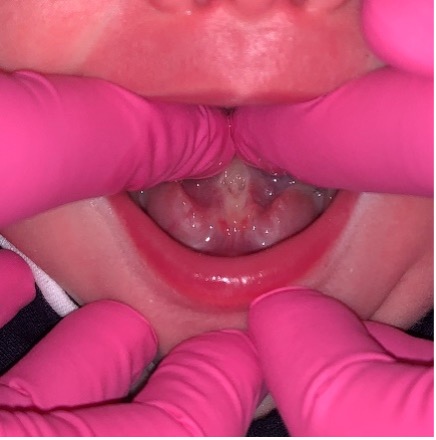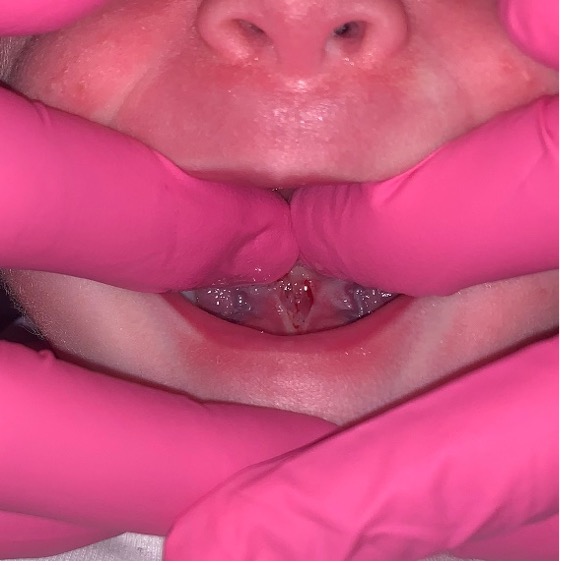What to Expect
Before the Procedure
A lip or tongue tie release, also known as a frenectomy, is a simple and quick procedure to correct restricted movement of the lip or tongue caused by restricted or tethered tissue (the frenulum). This procedure can help with feeding difficulties, speech development, sleep, and oral health issues in infants.
After the Procedure
After a lip or tongue tie release, parents are advised on proper aftercare for healing and preventing reattachment. Some mild discomfort or swelling is normal, but these side effects can be managed with recommended pain relief and cold compresses. The most difficult part of healing occurs between 3-5 days after the procedure, and full healing typically takes about 3 to 4 weeks. During this time, it’s important to follow aftercare instructions closely, including the recommended stretching exercises. Each child’s healing process may vary slightly, but most discomfort should subside within the first few days. Keeping the area clean and following a soft food diet for a few days will help your child in recovery. Follow-ups with lactation specialists, feeding therapists, physical therapists, or chiropractors may be necessary after Week One. If you notice any signs of infection or if your child seems unusually uncomfortable, please contact our office directly for further guidance.
Pain Management
Pain management is an important aspect of the lip or tongue tie release procedure to ensure your child’s comfort during recovery. After the procedure, we may recommend over-the-counter pain relievers, like acetaminophen or ibuprofen, to help alleviate any discomfort. Cold compresses can be used to reduce swelling and soothe pain. Freezing breast milk or formula into ice cubes and applying them to the affected area can also provide some relief. Please avoid using any OTC anesthetics containing benzocaine, such as Orajel.
Dr. Robinson will provide specific instructions to effectively manage any post-procedure discomfort. If you have any concerns about your child’s pain levels, please don’t hesitate to reach out to our office for guidance.
Healing Guide
Healing after a lip or tongue tie release can vary from baby to baby. Initially, you may notice some swelling and slight discomfort around the release site, which is completely normal. In the first few days, your baby might also exhibit changes in feeding patterns, such as increased fussiness or difficulty latching, as they adjust to the new range of motion. Over the following weeks, you should see gradual improvements, including more effective latching and less discomfort. Keep in mind that each child’s healing journey is unique; some may progress quickly, while others may take a bit longer to fully adjust. If you have concerns about your baby’s recovery, call our office directly to speak with one of our staff members.
View the photo gallery below to see different variations in the stages of healing, so you can know what to expect as your baby recovers from the procedure.






Stretches
Dr. Robinson will provide you with a list of post-procedure care guidelines to follow, including a series of stretches to help the frenulum heal in an elastic, mobile way. The first stretch should occur right before bed on the night of the procedure. Beginning the next day, we recommend performing these stretches at least 6 times per day (around every 3 hours during the daytime). A headlamp or flashlight can help with visibility.

Labial Frenum (Lip)
1. With clean hands, insert index fingers under the upper lip where the lip meets the upper jaw (the labial vestibule) and lift up and back towards the nose, covering the nostrils.
2. Hold this position for 10 seconds.
3. Repeat at least 6 times a day, or every 3 hours during the day.

Lingual Frenum (Tongue)
1. With clean hands, place your middle fingers on the chin to open the mouth wide.
2. Place both index fingertips under the tongue and at the top point of the diamond.
3. Use both index fingers to push the tongue up and back (towards the tonsils) in a forklift motion and hold for 10 seconds.
4. When done correctly, the diamond should go from short and wide to tall and skinny.
5. Repeat this stretch at least 6 times a day, or every 3 hours during the day.
Helpful Tips
Recovery can be a delicate process for both you and your baby. Here are some helpful tips to guide you through this recovery phase, focusing on enhancing feeding experiences and encouraging positive interactions as your little one adjusts.
- Use plenty of skin-to-skin contact to increase oxytocin levels & lower pain sensitivity.
- If latching has become difficult, consider taking a warm bath with your baby & trying to latch in the bath. In the first week, minor bleeding may occur during stretches and is normal.
- If your little one is squirmy during exercises, try using a swaddle.
- Expect extra drooling and saliva as your baby adjusts.
- While not necessary, wearing nitrile gloves may make the exercises easier.
- If stretching before a feed causes your baby to be averse to the bottle or breast, try changing the stretching schedule so that the stretch remains approximately every 3 hours, but does not take place immediately prior to a feeding.
If your child experiences a fever greater than 101 F, has uncontrolled bleeding, or refuses to feed for longer than 8 hours, call our office immediately for guidance.
Support & Resources
SPECIALIZED PHYSICIANS & PARTNERS
Feeding Therapists
Magnolia Pediatric Therapy
Speech/Feeding, Occupational Therapy & Lactation Counseling
337-419-0086
magnoliapediatrictherapy.com
Hope Therapy Center
Speech/Feeding, Occupational, & Physical Therapy
337-478-5880
hopetherapycenter.net
Therapy Works
Speech, Occupational/Feeding, & Physical Therapy
337-477-7883
therapyworkslakecharles.com
Lactation Consultants (IBCLC)
Megan Musso with Magnolia Pediatric Therapy
337-419-0086
magnoliapediatrictherapy.com
Therese Deroche with The Children’s Clinic
337-478-0086
ccswla.com
Courtney Deitch with Honeysuckle & Pearl
337-564-7953
honeysuckleandpearl.com
CHRISTUS Oschner Lake Area Hospital Mother Baby Clinic
337-430-5300
ochsner.org
Physical Therapists
Partners in Physical Therapy
Physical Therapy/Bodywork
337-439-3344
partnersinpt.com/pediatrics
Maxx Physical Therapy
Physical Therapy/Bodywork
337-508-2505
maxxpt.com
Maternal / Post-Partum Mental Health
Mellisa Booth with Sereine Counseling
337-492-0940
sereinecounseling.com
Chiropractic Services
Dr. Laurie Baynard with Women & Children’s Chiropractic
337-240-6619
drlauriebaynard.com
Dr. Pattie Ward with Ward Chiropractic
Chiropractic & Craniosacral Therapy
337-990-5497
ward-chiro.com
Frequently Asked Questions
Most babies experience some swelling and mild discomfort, along with potential changes in feeding patterns as they adjust. You can expect some difficulty feeding, increased saliva production, and fussiness following the procedure. Follow all Dr. Robinson’s aftercare guidelines to minimize discomfort and promote healing.
Gentle comforting techniques, skin-to-skin contact, and ensuring a calm feeding environment can help soothe your baby. Pain relief medications specifically formulated for infants and children may be prescribed to reduce pain and soreness.
Immediately following the procedure in our dedicated mother/baby room!
It’s usually recommended to perform stretches or exercises six times a day, as guided by your healthcare provider, to promote healing and prevent reattachment. If stretching before feeding causes the baby to refuse the bottle/breast, try completing stretches at a random time (still 6 times/day every 3ish hours) throughout the day.
Look for increased redness, swelling, discharge, or a persistent fever. If any of these occur, contact our office promptly for guidance on how to proceed.
Yes, fussiness and latching difficulties are common as your baby adjusts to the new range of motion. This is temporary and should subside within a week after the procedure.
Healing can vary, but most babies see significant improvement within 2 weeks, with continued progress over several weeks.
Yes, ongoing support from a lactation consultant and other specialists is crucial to help address any feeding challenges and ensure successful breastfeeding.
Generally, there are no specific dietary restrictions for breastfeeding mothers post-procedure. For young children who no longer breastfeed, we recommend parents begin a soft food diet for the first few weeks to avoid additional trauma to the surgical site.
Follow-up appointments include a one week post-op to see how site is healing and for Dr. Robinson to assess progress, and a three week post-op to assess whether site(s) are healed enough to stop stretching. If you have questions or concerns in the meantime, don’t hesitate to reach out to our knowledgeable staff. You should continue consultations with an IBCLC (International Board-Certified Lactation Consultant) after the procedure, as they provide vital support and guidance for both you and your baby during this transitional phase. Follow-ups with a Speech Pathologist or Occupational Therapist specializing in feeding are recommended; they can introduce suck trainingexercises that promote effective feeding techniques. If your baby exhibits tightness or difficulty turning their head, exploring physical therapy, craniosacral therapy, or chiropractic services may also be beneficial. These appointments help monitor progress and address any concerns, ensuring your baby receives comprehensive care throughout their recovery journey.

